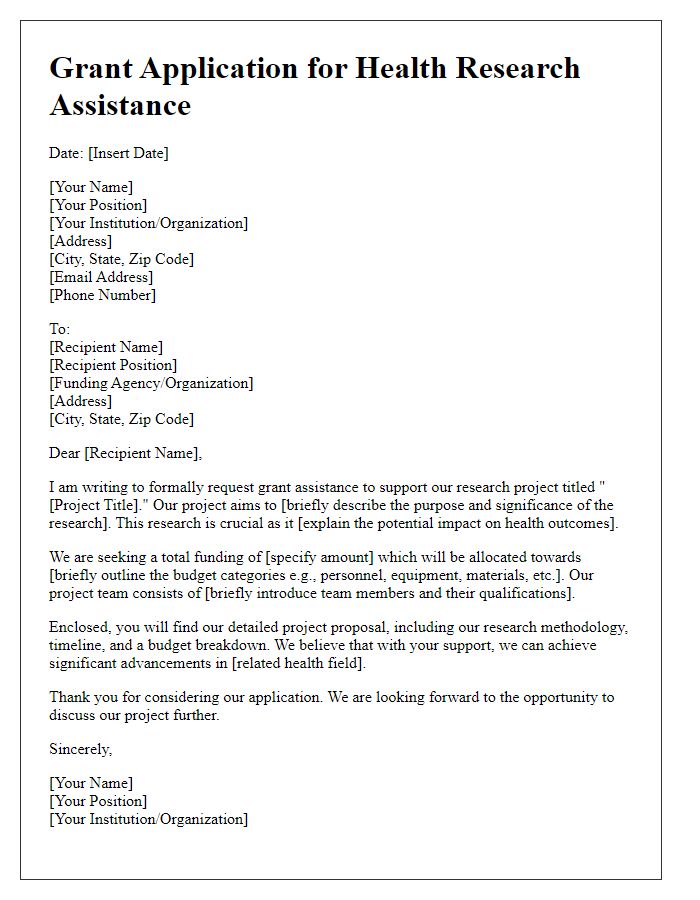Are you looking to secure funding for your vital medical research? Crafting the perfect application letter can make all the difference in capturing the attention of potential sponsors. A well-structured letter not only highlights the significance of your research but also underscores your commitment to advancing healthcare solutions. Join us as we explore the essential components of a compelling funding application letter that can help turn your vision into reality!

Clear Research Proposal
A clear research proposal outlines a structured approach to medical investigation, detailing objectives, methods, and expected outcomes. The proposal should start with a compelling introduction, including relevant statistics such as disease prevalence or funding gaps, to establish the significance of the research. Following the introduction, a literature review highlights previous studies, identifying knowledge gaps and showing how the proposed research will contribute to existing knowledge. The methodology section details experimental design, sample size considerations (typically 30 to 300 participants), and data analysis techniques. A timeline (often spanning 12 to 36 months) outlines key milestones, ensuring feasibility. Budgetary considerations, including equipment costs (ranging from $500 to $50,000), personnel expenses, and material supplies, must be detailed to demonstrate the financial needs of the project. Finally, the proposal wraps up with the potential impact of the research, emphasizing how findings could translate into advancements in medical treatments or public health policies.
Detailed Budget Outline
A detailed budget outline plays a crucial role in medical research funding applications, clearly delineating the financial resources required for various project components. Essential categories include personnel costs, such as salaries for principal investigators (typically over $80,000 annually) and research assistants, as well as equipment expenses for specialized tools, like MRI machines (ranging from $150,000 to $3 million) needed for imaging studies. Additionally, supplies such as reagents and laboratory materials (estimated at $5,000 to $50,000), travel expenses for conferences or collaborations (potentially $1,000 to $5,000), and indirect costs or overhead (usually around 10-20%) must be meticulously documented. Each line item should reflect a strong rationale, ensuring alignment with the project's research goals and compliance with funding agency guidelines.
Principal Investigator's Credentials
The Principal Investigator (PI) must possess advanced degrees, typically a Ph.D. or M.D., with expertise in the specific area of medical research, such as oncology or neuroscience. Strong publication records in peer-reviewed journals, often exceeding 20 articles, highlight ongoing contributions to the scientific community. Experience leading research projects, demonstrated by securing previous funding, such as National Institutes of Health (NIH) grants totaling over $500,000, showcases the ability to manage complex studies effectively. Additionally, affiliations with reputable institutions, such as Harvard Medical School or Johns Hopkins University, enhance credibility and access to necessary resources. Collaborative networks formed with fellow researchers and practitioners can significantly impact the project's success and innovation potential.
Expected Impact and Outcomes
Completion of this medical research project aims to significantly improve patient outcomes in chronic disease management, particularly diabetes mellitus and hypertension, affecting millions globally. The innovative treatment protocols developed through this research can contribute to a projected 20% decrease in hospitalization rates, leading to heightened quality of life and reduced healthcare costs estimated at $5 billion annually. Collaborations with prominent institutions such as the Mayo Clinic and Johns Hopkins University will enhance credibility and facilitate knowledge transfer. Furthermore, dissemination of findings via peer-reviewed journals and clinical conferences is expected to reach over 10,000 healthcare professionals, fostering widespread adoption of effective practices and ultimately affecting policy change in chronic disease management within the healthcare system.
Alignment with Funding Agency Goals
Funding agencies prioritizing innovative medical research aim to improve public health outcomes and advance therapeutic interventions. For instance, the National Institutes of Health (NIH) focuses on initiatives that address pressing health challenges, such as cancer, cardiovascular diseases, and mental health disorders. Proposals that align with these goals often emphasize novel methodologies, interdisciplinary collaboration, and potential for significant impact on patient care. Research addressing prevalent issues, such as diabetes affecting over 34 million Americans, enhances the relevance of projects, showcasing a commitment to society's health needs. Moreover, emphasizing partnerships with institutions like the World Health Organization (WHO) can strengthen proposals, highlighting global health initiatives and collaborative research that tackle diseases affecting millions worldwide.
















Comments